Copyright 2011 by Le Cherche Midi Editeur English-language translation copyright 2012 by Jeannette Seaver All rights reserved. No part of this book may be reproduced in any manner without the express written consent of the publisher, except in the case of brief excerpts in critical reviews or articles. All inquiries should be addressed to Arcade Publishing, 307 West 36th Street, 11th Floor, New York, NY 10018. Arcade Publishing books may be purchased in bulk at special discounts for sales promotion, corporate gifts, fund-raising, or educational purposes. Special editions can also be created to specifications. For details, contact the Special Sales Department, Arcade Publishing, 307 West 36th Street, 11th Floor, New York, NY 10018 or .
Arcade Publishing is a registered trademark of Skyhorse Publishing, Inc., a Delaware corporation. Visit our website at www.arcadepub.com. 10 9 8 7 6 5 4 3 2 1 Library of Congress Cataloging-in-Publication Data is available on file. Cover design by Laura Klynstra Print ISBN: 978-1-62872-590-2 Ebook ISBN: 978-1-61145-858-9 Printed in China Contents Amuse Bouche:
A Little Taste of What Is to Follow Politics and cuisine? While this might seem an unlikely combination at first glance, the two share singular affinities. Ambassadors of their departments, French deputies represent their constituents at the Palais Bourbon, home of the National Assemblythe forum where France conducts its politics. Beyond the political aspect of their role, however, these deputies all enjoy good cuisine, and have agreed to share and exhibit with pride a sample of the gastronomy of their particular land le terroir .
Each recipe, each dish is made with the prized products, meat and sea fare, identified with their district. This book is the personal mirror of various culinary traditions born in the course of a long history, passed down through the generations. Today each traditional cuisine, while retaining its authenticity, has traveled beyond its original borders and can be enjoyed throughout all of Franceand the world. Like the scope of their politics, the various regional cuisines presented in this book can be modest or grand, innovative or orthodox, stimulating or soothing. The one basic common denominator is the quality of the products and ingredients assembled for each preparation. Combining flavors is the second act that will determine whether a magical dish appears on the table.
Every five years, deputies in France stand for election, in a sort of grand electoral cook-off. Candidates may get roasted, skewered, raked over the coals, stewed in their own juices, or grilled by their constituents, but at the end of day all are in the same position, presented on the same platter. Both crusty veterans and young sprouts are subject to the electorates scrutiny, and only the candidates best able to respond to the issues of the moment will get the thumbs-up and avoid the compost heap. In French Country Cooking: Authentic Recipes from Every Region , for the first time, deputies representing every department of metropolitan France, including our overseas territories, have contributed to a collective cookbook offering savory and sweet, time-tested and timeless dishes. It is with great pleasure that I invite you to share the panoply of gourmand moments with us. You will discover never-published recipes, and will even be surprised by some new combinations of flavors.
My hope is that reading this book will inspire your own creativity, as well as ignite your curiosity to explore our rich and multifaceted country.  Franoise Branget Deputy of Doubs Notes from the American Editor and Translator This book, an armchair travelogue of France with recipes emblematic of each district, will give the reader a rare opportunity of discovering la France profonde , off the beaten track. Endowed with landscapes as rich as they are diverse, fertile farmlands and orchards throughout, Frances singular patrimony is its incredibly varied gastronomyan art refined over centuries. History points out that a great many of the dishes considered today part of our gastronomic glory trace their roots to a time when rural France suffered extreme poverty. The only way for the countrymen to survive was to avail themselves of all the simple elements growing nearby. Some plants they gathered from natures bounty, and some they grew themselves.
Franoise Branget Deputy of Doubs Notes from the American Editor and Translator This book, an armchair travelogue of France with recipes emblematic of each district, will give the reader a rare opportunity of discovering la France profonde , off the beaten track. Endowed with landscapes as rich as they are diverse, fertile farmlands and orchards throughout, Frances singular patrimony is its incredibly varied gastronomyan art refined over centuries. History points out that a great many of the dishes considered today part of our gastronomic glory trace their roots to a time when rural France suffered extreme poverty. The only way for the countrymen to survive was to avail themselves of all the simple elements growing nearby. Some plants they gathered from natures bounty, and some they grew themselves.
Every possible part was used, either to feed the family, to fertilize the fields, or to feed the livestock. And the animalsbesides producing milk or eggs or offspringwere in turn used for food from head to hoof. Driven by necessity, the rural householder learned how best to utilize each part of the beef or lamb, pig or chicken, including delicacies made of the innards and the extremities. The recipes in this book for the most part date from long ago, emanating from the rural terroir , the small villages of la France profonde , from a time when farmers choices to feed themselves were limited to the produce of their own landand when native creativity and innate ingenuity arose to transform the most humble ingredients into delectable fare. Most of the deputies in the French Parliament who contributed to this collection were handed down a recipe by a grandmother or mother, secrets of family lore. Their sharing of their closely guarded treasures enables todays reader to enjoy traditional cooking and to survey the origins of French gastronomy.
From these timeworn memoranda, scribbled in patois or local dialect and for the most part fragmentary or imprecise, recipes evolved into what is today our classic French cuisine. Jeannette M. Seaver For the readers convenience, and to avoid repetition, I include below a few basic components that are used over and over throughout the book. Tr . AIOLI 2 garlic cloves, germ removed 1 large egg yolk 1 tablespoon Dijon mustard 1 tablespoon lemon juice 1 1/2 cups olive oil pepper and salt Put ingredients in the blender except for the oil. Turn blender on, and slowly trickle oil until mixture becomes firm.
If you feel it is too thick, add a few drops water. If too thin, add 1 slice bread (crust removed), and mix in blender for a few seconds. BOUQUET GARNI To flavor a stock or other cooking liquid, a bunch of aromatic herbs is tied with string and immersed in the liquid. Usually the bouquet consists of a few sprigs of parsley, thyme, rosemary, bay leaves, and chives, though the composition may vary. The bundle is removed before using the stock. CRME FRAICHE In a bowl, mix 1 cup heavy cream and 2 tablespoons sour cream.
Cover and let sit overnight or a bit longer. Stir the crme fraiche and refrigerate. PTE BRISE 2 cups unbleached flour 2 sticks unsalted butter, cut into pieces 1 teaspoon salt 1 teaspoon sugar cup ice water Pulse all ingredients in the food processor until it comes together. Remove from processor, and form a ball of dough with your hands. Wrap and refrigerate at least one hour. STOCK Stock can be made with the bones of beef, veal, chicken, or fish.
Immerse the bones in a kettle of water with carrots, leeks, onion, celery, bouquet garni, peppercorns, and salt, and simmer for at least an hour, or longer for a stronger stock. Strain, discarding the solids, and refrigerate. A vegetable stock may be made without bones. For a dark stock, or fond brun , the bones and vegetables are roasted before simmering. Fish stock, fumet de poisson , is made with white wine. tienne Blanc, saluting his ancestresses in his recipe title, plays on the fact that the regions foremost chef, Georges Blanc, took over a restaurant already made famous by his mother, La Mre Blanc. tienne Blanc, saluting his ancestresses in his recipe title, plays on the fact that the regions foremost chef, Georges Blanc, took over a restaurant already made famous by his mother, La Mre Blanc.

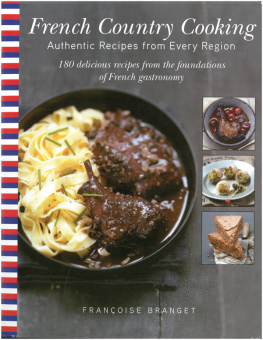

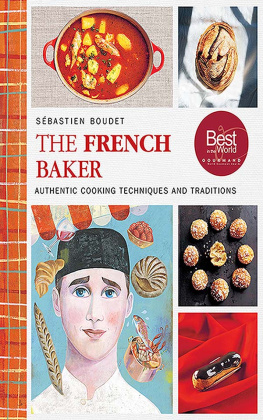




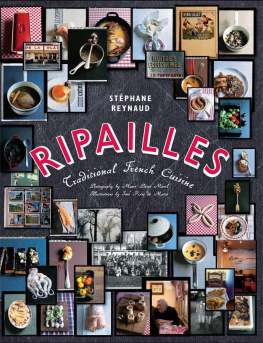

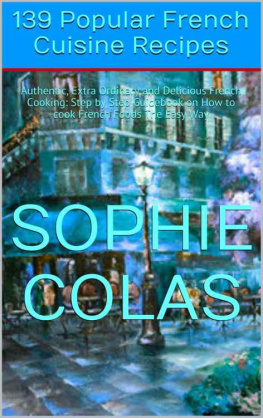
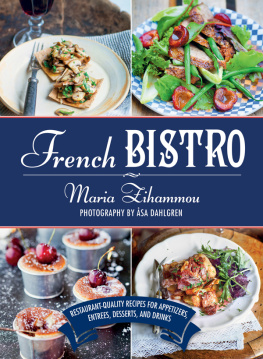

 Franoise Branget Deputy of Doubs Notes from the American Editor and Translator This book, an armchair travelogue of France with recipes emblematic of each district, will give the reader a rare opportunity of discovering la France profonde , off the beaten track. Endowed with landscapes as rich as they are diverse, fertile farmlands and orchards throughout, Frances singular patrimony is its incredibly varied gastronomyan art refined over centuries. History points out that a great many of the dishes considered today part of our gastronomic glory trace their roots to a time when rural France suffered extreme poverty. The only way for the countrymen to survive was to avail themselves of all the simple elements growing nearby. Some plants they gathered from natures bounty, and some they grew themselves.
Franoise Branget Deputy of Doubs Notes from the American Editor and Translator This book, an armchair travelogue of France with recipes emblematic of each district, will give the reader a rare opportunity of discovering la France profonde , off the beaten track. Endowed with landscapes as rich as they are diverse, fertile farmlands and orchards throughout, Frances singular patrimony is its incredibly varied gastronomyan art refined over centuries. History points out that a great many of the dishes considered today part of our gastronomic glory trace their roots to a time when rural France suffered extreme poverty. The only way for the countrymen to survive was to avail themselves of all the simple elements growing nearby. Some plants they gathered from natures bounty, and some they grew themselves.